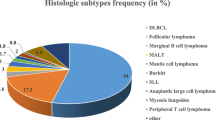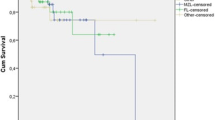Abstract
Background and purpose
Endemic Burkitt’s lymphoma (eBL) remains the prevalent form of paediatric cancer in tropical Africa with subtle pathological differences. This calls for intensified efforts to validate the global prognostic markers within local settings for improved cancer treatment and survival. This study proposes prognostic markers for enhanced eBL treatment and management.
Patients and method
One hundred and eighty histologically and/or clinically diagnosed BL patients at Komfo Anokye Teaching Hospital, Kumasi, Ghana were eligible for this cross-sectional eight-year retrospective study. Biochemical, clinical and demographic data, before chemotherapy administration, were documented and examined for their progression-free (PFS) and overall survival (OS) significance.
Results
A mean age of 6 (SD=2.7, range: 1–16) years was observed with general male dominance (M:F=1.69:1). Total serum lactate dehydrogenase (HR=2.04; 95% CI, 1.25–3.32; log rank=8.3; p=0.004), serum creatinine (HR=3.59; 95% CI, 1.62–7.98; log rank=15.4; p=0.002) and St. Jude stage (HR=1.74; 95% CI, 1.11–2.73; log rank=8.0; p=0.015) were important independent prognostic biochemical markers for both PFS and OS. Age, serum calcium, uric acid, potassium, sodium and phosphorus were non-prognostic.
Conclusion
The better monitoring of these prognostic indices coupled with risk-stratification treatment may improve patients’ survival, especially in resource-limited settings.
Similar content being viewed by others
References
Magrath I (1990) The pathogenesis of Burkitt’s lymphoma. Adv Cancer Res 55:133–270
Ansari M, Krajinovic M (2007) Pharmacogenomics in cancer treatment defining the genetic bases for inter-individual differences in response to chemotherapy. Curr Opin Pediatr 19:15–22
Shipp MA (1993) for The International Non-Hodgkin’s Lymphoma Prognostic Factors Project: a predictive model for aggressive Non-Hodgkin’s Lymphoma: The International Non-Hodgkin’s Lymphoma Project. N Engl J Med 329:987–994
Hermans J, Krol ADG, van Groningen K et al (1995) International Prognostic Index is valid for all malignant grades. Blood 88:1460–1463
Federico M, Umberto V, Zinzani PL et al (2000) Prognosis of follicular lymphoma: a predictive model based on a retrospective analysis of 987 cases. Blood 95:783–789
Nicolaides C, Fountzilas G, Zoumbos N et al (1998) Diffuse large cell lymphomas: identification of prognostic factors and validation of the international Non-Hodgkin’s Lymphoma Prognostic Index. Oncology 55:405–415
Nocolaides C, Dimon S, Pavlidis N (1998) Prognostic factors in aggressive non-Hodgkin’s lymphomas. Oncologist 3:189–197
Plancarte F, López-Guillermo A, Arenillas L et al (2006) Follicular lymphoma in early stages: high risk of relapse and usefulness of the Follicular Lymphoma International Prognostic Index to predict the outcome of patients. Eur J Haematol 76:58–63
Pedrosa MF, Pedrosa F, Lins MM et al (2007) Non-Hodgkin’s lymphoma in childhood: clinical and epidemiological characteristics and survival analysis at a single centre in Northeast Brazil. J Pediatr (Rio J) 83:547–554
Owusu L, Yeboah FA, Sei-Akoto A et al (2010) Clinical and epidemiological characterisation of Burkitt’s lymphoma: an eight-year case study at Komfo Anokye Teaching Hospital, Ghana. Br J Biomed Sci 67:9–14
Cheson BD, Horning SJ, Coiffier B et al (1999) Report of an international workshop to standardize response criteria for non-Hodgkin’s lymphomas. J Clin Oncol 17:1244–1253
Bland JM, Altman DG (2004) The logrank test. BMJ 328:1073
Cabanilla F, Burke JS, Smith TL et al (1978) Factors predicting response and survival in adults with advanced non-Hodgkin’s lymphoma. Arch Intern Med 138:413–418
Schneider RJ, Scibert K, Passe S et al (1980) Prognostic significance of serum lactate dehydrogenase in malignant lymphomas. Cancer 46:139–143
Fisher RI, Hubbard SM, De Vita VT et al (1981) Factors predicting long-term survival in diffuse mixed, histiocytic or undifferentiated lymphoma. Blood 58:45–51
Coiffier B, Gisselbrecht C, Vose JM et al (1991) Prognostic factors in aggressive malignant lymphomas: description and validation of a prognostic index that could identify patients requiring a more intensive therapy. The Groupe d’Etudes des Lymphomas Aggresifs. J Clin Oncol 9:211–219
Hoskin PJ, Ng V, Spinelli JJ et al (1991) Prognostic variables in patients with diffuse large cell lymphoma treated with MACOP-B. J Clin Oncol 9:220–226
Leonard RC, Hayward RL, Prescott RJ et al (1991) The identification of discrete prognosis groups in low-grade non-Hodgkin’s lymphoma. Ann Oncol 2:655–662
Lopez-Guillermo A, Montserrat E, Bosch F et al (1994) Applicability of the International Index for aggressive lymphomas to patients with low-grade lymphoma. J Clin Oncol 12:1343–1348
Pan L, Beverly PCL, Isaacson PG (1991) Lactate dehydrogenase (LDH) isoenzymes and proliferative activity of lymphoid cells: an immunocytochemical study. Clin Exp Immunol 86:240–245
Gaw A, Cowan RA, O’Reilly DStJ et al (1999) Clinical biochemistry, 2nd ed. Harcourt Brace and Company, Edinburgh, pp 12–44, 64–72
Velasquez WS, Fuller LM, Jaganuath S et al (1991) Stage I and II diffuse large cell lymphoma: prognostic factors and long-term results with CHOP-bleo and radiation. Blood 77:942–947
Dixon DO, Neilan B, Jones SE et al (1986) Effect of age on the therapeutic outcome in advanced diffused histiocytic lymphoma. The Southwest Oncology Group Experience. J Clin Oncol 4:295–305
Author information
Authors and Affiliations
Corresponding author
Rights and permissions
About this article
Cite this article
Arthur, F.K.N., Owusu, L., Yeboah, F.A. et al. Prognostic significance of biochemical markers in African Burkitt’s lymphoma. Clin Transl Oncol 13, 731–736 (2011). https://doi.org/10.1007/s12094-011-0724-8
Received:
Accepted:
Published:
Issue Date:
DOI: https://doi.org/10.1007/s12094-011-0724-8




